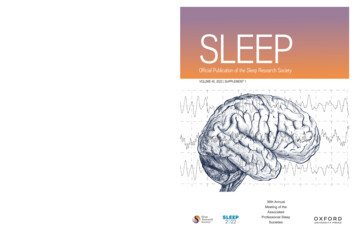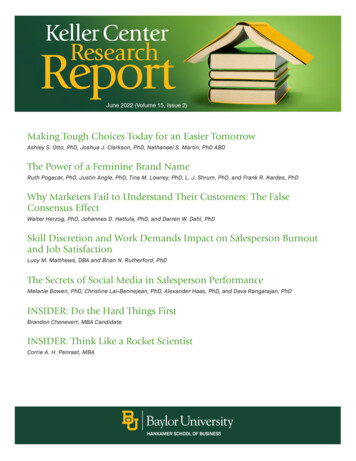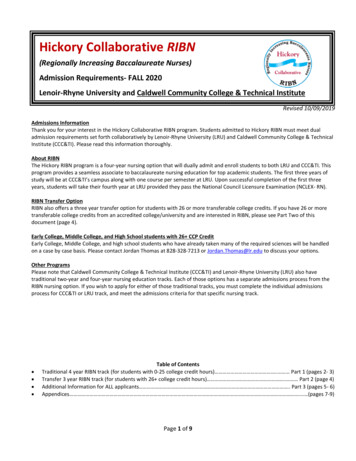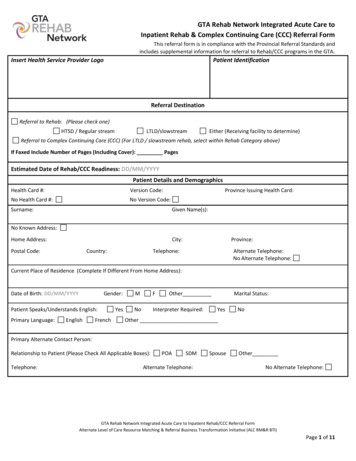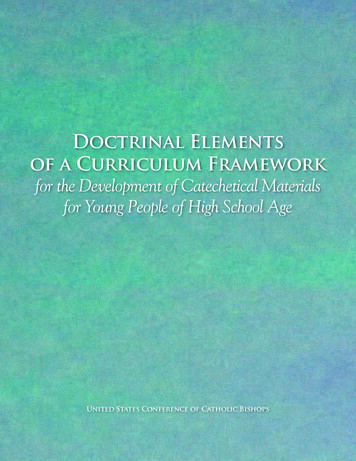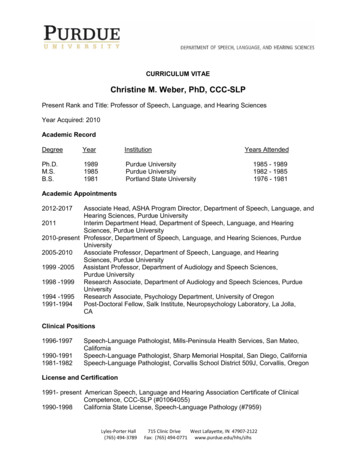
Transcription
CURRICULUM VITAEChristine M. Weber, PhD, CCC-SLPPresent Rank and Title: Professor of Speech, Language, and Hearing SciencesYear Acquired: 2010Academic 81Purdue UniversityPurdue UniversityPortland State UniversityYears Attended1985 - 19891982 - 19851976 - 1981Academic Appointments2012-2017Associate Head, ASHA Program Director, Department of Speech, Language, andHearing Sciences, Purdue University2011Interim Department Head, Department of Speech, Language, and HearingSciences, Purdue University2010-present Professor, Department of Speech, Language, and Hearing Sciences, PurdueUniversity2005-2010Associate Professor, Department of Speech, Language, and HearingSciences, Purdue University1999 -2005 Assistant Professor, Department of Audiology and Speech Sciences,Purdue University1998 -1999 Research Associate, Department of Audiology and Speech Sciences, PurdueUniversity1994 -1995 Research Associate, Psychology Department, University of Oregon1991-1994Post-Doctoral Fellow, Salk Institute, Neuropsychology Laboratory, La Jolla,CAClinical e Pathologist, Mills-Peninsula Health Services, San Mateo,CaliforniaSpeech-Language Pathologist, Sharp Memorial Hospital, San Diego, CaliforniaSpeech-Language Pathologist, Corvallis School District 509J, Corvallis, OregonLicense and Certification1991- present American Speech, Language and Hearing Association Certificate of ClinicalCompetence, CCC-SLP (#01064055)1990-1998California State License, Speech-Language Pathology (#7959)Lyles-Porter Hall(765) 494-3789715 Clinic DriveWest Lafayette, IN 47907-2122Fax: (765) 494-0771 www.purdue.edu/hhs/slhs
Page 2Awards and Honors2012Health and Human Sciences Award for Excellence in Undergraduate EducationCollege of Health and Human Sciences, Purdue University2010-2011Outstanding Undergraduate Instructor Speech, Language, and HearingSciences, Purdue University2007 – 2008 Outstanding Undergraduate Instructor Speech, Language, and HearingSciences, Purdue University2003 - 2004 Best Faculty Instructor Department of Audiology and Speech Sciences, PurdueUniversity2001 - 2002 Outstanding Graduate InstructorDepartment of Audiology and Speech Sciences, Purdue University2000 - 2001 Outstanding Instructor Department of Audiology and Speech Sciences, PurdueUniversity1987David Ross Doctoral Dissertation Fellowship, Purdue University1985American Speech and Hearing Association Foundation ScholarshipMembership in Academic and Professional tive Neuroscience SocietyAmerican Speech, Language, and Hearing AssociationThe Society for NeurosciencePublished WorkJournal Articles (underline students, P post-doctoral fellows)Leonard, L. B., Christ, S. L., Deevy, P, Karpicke, J.D., Weber, C., Haebig, E., Kueser, J.B.,Souto, S., & Krok, W. (2021, in press). A multi-study examination of the role of repeatedspaced retrieval in the word learning of children with developmental language disorder.Journal of Neurodevelopmental Disorders.Haebig, E., Leonard, L. B., Deevy, P., Schumaker, J., Karpicke, J., & Weber, C. (2021, inpress). The neural underpinnings of processing newly taught semantic information: Therole of retrieval practice. Journal of Speech, Language, & Hearing Research.Walsh, B, Christ, S., & Weber, C. (2021, in press). Exploring relationships among risk factors forpersistence in early childhood stuttering. Journal of Speech, Language, & HearingResearch.Gerwin, K.L., Leonard, L. B., Schumaker, J., Deevy, P., Haebig, E., & Weber, C. (2021). Noveladjective processing in preschool children: Evidence from event-related brain potentials.Journal of Speech, Language, & Hearing Sciences, 64 (2), 542-56.Usler, E., & Weber, C. (2021). Emotion processing in children who do and do not stutter: AnERP study of electrocortical reactivity and regulation to peer facial expressions, Journalof Fluency Disorders, 67, 105208.
Page 3Usler, E., Foti, D., & Weber, C. (2020). Emotional reactivity and regulation in 5- to 8-year-oldchildren: An ERP study of own-age face. International Journal of Psychophysiology, 156,60-68.Walsh, B., Bostian, A., Tichenor, S., Brown, B., & Weber, C. (2020). Disfluency characteristic of4-5 year-old children who stutter and their relationship to stuttering persistence andrecovery. Journal of Speech, Language, & Hearing Sciences, 63 (8), 2555-2566.Gerwin, K., & Weber, C. (2020). Neural indices mediating rhyme discrimination differ for some4-5 year old children who stutter regardless of eventual recovery or persistence. Journalof Speech, Language, & Hearing Sciences, 63 (4), 1053-1070.Luckman, C., Wagovich, S., Weber, C., Brown, B., Chang S-E, Hall, N., & Ratner, N., (2020).Lexical diversity and lexical skills in children who stutter. Journal of Fluency Disorders,63, 10574.Walsh, B., Smith, A., Christ, S. L., & Weber, C. (2019). Sympathetic nervous system activity inpreschoolers who stutter. Frontiers in Human ard, L. B., Deevy, P., Karpicke, J. D., Christ, S., Weber, C., Kueser, J., & PHaebig, E.(2019). Adjective learning in young typically developing children and children withdevelopmental language disorder: A retrieval-based approach. Journal of Speech,Language, and Hearing Research, 62, 4433-4449.Gerwin, K., Brosseau-Lapre, F., Brown, B. Christ, S., & Weber, C. (2019). Rhyme productionstrategies distinguish stuttering recovery and persistence. Journal of Speech, Language,& Hearing Sciences, 62(9), 3302-3319.Leonard, L.B., Karpicke, J., Weber, C., Christ, S., PHaebig, E., Souto, S., Kueser, J., Krok, W.(2019). Retrieval-based word learning in typically developing children and children withdevelopmental language disorder I: The benefits of repeated retrieval. Journal ofSpeech, Language, & Hearing Sciences, 62, 932-943.PHaebig, E., Leonard, L.B., Deevy, P., Karpicke, J., Christ, S., Usler, E., Kueser, J., Souto, S.,Krok, W., & Weber, C., (2019). Retrieval-based word learning in young typicallydeveloping children and children with developmental language disorder II: A comparisonof retrieval schedules. Journal of Speech, Language, & Hearing Sciences, 62, 944-964.Leech, K., Ratner, N., Brown, B., & Weber, C. (2019). Language growth predicts stutteringpersistence over and above family history and treatment experience: Response toBothe. Journal of Speech, Language, & Hearing Sciences, 62, 1371-1372.Mohan, R., & Weber, C. (2018). Neural activity reveals effects of aging on inhibitory processesduring word retrieval, Aging, Neuropsychology, and Cognition, DOI:10.1080/13825585.2018.1519105Walsh, B., Usler, E., Bostian, A., Mohan, R., Gerwin, K., Brown, B., Weber, C., & Smith, A.(2018). What are predictors for persistence in childhood stuttering? Seminars in Speech
Page 4& Language, 39(4), 299-312.PHaebig, E., Leonard, L. B., Usler, E., Deevy, P., & Weber, C. (2018). An initial investigation ofthe neural Correlates of word processing in preschoolers with specific languageimpairment. Journal of Speech, Language, and Hearing Research, 61, 729-739, doi:10:1044/2017 JSLHR-L-17-0249.Kreidler, K., Hampton Wray, A., Usler, E., & Weber, C. (2017). Neural indices of semanticprocessing in early childhood distinguish eventual stuttering persistence andrecovery. Journal of Speech, Language, & Hearing Research, 60, 3118-3134, doi:10.1044/2017 JSLHR-S-17-0081.PHaebig, E., Weber, C., Leonard, L. B., Deevy, P., & Tomblin, J. B. (2017). Neural indices oflanguage processing in adolescents with language impairment: An assessment oflanguage trajectories. Journal of Neurodevelopmental Disorders, 9(22), 1-21,doi: 10.1186/s11689-017-920-1Smith, A., & Weber, C., (2017). How stuttering develops: The Multifactorial Dynamic Pathwaystheory. Journal of Speech, Language, & Hearing Sciences, 60, 2483-2505, doi:10.1044/2017-JSLHR-S-16-0343.Leech, KA, Bernstein Ratner, N., Brown B., & Weber, C. (2017). Preliminary evidence thatgrowth in productive language differentiates childhood stuttering persistence andrecovery. Journal of Speech, Language, & Hearing Sciences, 60, 3097-3109, doi:10:1044/2017 JSLHR-S-16-0371.Usler, E., Smith, A., & Weber, C. (2017). A lag in speech motor coordination during sentenceproduction is associated with stuttering persistence in young children. Journal ofSpeech, Language, & Hearing Sciences, 60, 51-61. Doi: 10.1044/2016 JSLHR-D-150367.Smith, A., & Weber, C (2016). Childhood stuttering: Where are we and where are we going?Seminars in Speech and Language, 37 (4), 291-297. PMCID: PMC5257259.Mohan, R., & Weber, C., (2015). Neural systems mediating processing of sound units oflanguage distinguish recovery versus persistence in stuttering. Journal ofNeurodevelopmental Disorders, 7:28. PMID: 26284147Usler, E., & Weber-Fox, C. (2015). Neurodevelopment for Syntactic Processing DistinguishesChildhood Stuttering Recovery versus Persistence. Journal of NeurodevelopmentalDisorders, 7:4. PMID: 25657823Spencer, C., & Weber-Fox, C. (2014). Preschool speech articulation and nonword repetitionabilities may help predict eventual recovery or persistence of stuttering. Journal ofFluency Disorders, 41, 32-46. PMID: 25173455PPurdy, J. D., Leonard, L. B., Weber-Fox, C., & Kaganovich, N. (2014). Decreased sensitivity tolong-distance dependencies in children with a history of specific language impairment:Electrophysiological Evidence. Journal of Speech, Language, & Hearing Research, 57(3), 1040-1059. PMID: 24686983
Page 5Hampton Wray, A., & Weber-Fox, C. (2013). Specific aspects of cognitive and languageproficiency account for variability in neural indices of semantic and syntactic processingin children. Journal of Developmental Cognitive Neuroscience, 5, 149-171.Weber-Fox, C., Hampton Wray, A., & PArnold, H. (2013). Early childhood stuttering andelectrophysiological indices of language processing. Journal of Fluency Disorders, 38,206-21. PMID: 25657823PKaganovich, N., Kim, J., Herring, C., Schumaker, J., MacPherson, M., & Weber-Fox, C. (2013).Musicians show general enhancement of complex sound encoding and better inhibitionof irrelevant auditory change in music: An ERP study. European Journal ofNeuroscience, 37, 1295-307. PMID: 23301775Smith, A., Goffman, L., PSasisekaran, J., & Weber-Fox, C. (2012). Language and motor abilitiesof preschool children who stutter: Evidence from behavioral and kinematic indices ofnonword repetition performance. Journal of Fluency Disorders, 37, 344-358.Bauman, J., Hall, N. E., Wagonvich, S. A, Weber-Fox, C. M., & Ratner, N. B. (2012) Past tensemarking in the spontaneous speech of preschool children who do and do not stutter.Journal of Fluency Disorders, 37, 314-324.PMalaia, E., Wilbur, R.B., Weber-Fox, C. (2012). Effects of verbal event structure on onlinethematic role assignment Journal of Psycholinguistic Research. 41 (5), 323-345.PSasisekaran, J., & Weber-Fox, C. (2012). Cross-sectional study of phoneme and rhymemonitoring abilities in children between 7 and 13 years. Applied Psycholinguistics, n33,253-279.Smith, A, Sadagopan, N., Walsh, B., & Weber-Fox. C. (2010). Increasing phonologicalcomplexity reveals heighted instability in inter-articulatory coordination in adults whostutter. Journal of Fluency Disorders (35), 1-18.Weber-Fox, C., Leonard, L. B., Hampton, A., & Tomblin, B. J. (2010). Electrophysiologicalcorrelates of rapid auditory and linguistic processing in adolescents with specificlanguage impairment. Brain and Language, 115, 162-181.PKaganovich, N., Hampton, A. & Weber-Fox, C. (2010). Non-linguistic auditory processing andworking memory update in pre-school children who stutter: An electrophysiologicalstudy. Developmental Neuropsychology, 35 (6), 712-736.PSasisekaran, J., Smith, A., Sadagopan, N., & Weber-Fox, C. (2010). Nonword Repetition inChildren and Adults: Effects on movement coordination. Developmental Science, 13(3),521-532.Basu, M., Krishnan, R., & Weber-Fox, C. (2010). Degraded brainstem representations of tonalsweeps in children with specific language impairment. Developmental Science, 13, 7791.PMalaia, E., Wilbur, R., & Weber-Fox, C. (2009). ERP evidence for conceptual event structureeffects on syntactic processing. Brain and Language, 108, 145-158.
Page 6Hampton, A., & Weber-Fox, C. (2008) Nonlinguistic auditory processing in adults who stutter.Journal of Fluency Disorders, 33 (4), 253-330.Weber-Fox, C., & Hampton, A. (2008). Stuttering and natural speech processing of semanticand syntactic constraints on verbs. Journal of Speech, Language, and HearingResearch, 51(5), 1058-1071.Weber-Fox, C., Spruill, J. E. III, Spencer, R., & Smith, A. (2008). Atypical neural functionsunderlying phonological processing and silent rehearsal in children who stutter.Developmental Science, 11(2), 321-337.Kemmerer, D., Weber-Fox, C., Price, K., Zdansczk, C., & Way, H. (2007). Big browndog or brown big dog? An electrophysiological study of semantic constraints onpronominal adjective order. Brain and Language, 100 (3), 238-256.Walsh, B., Smith, A., Weber-Fox, C. (2006). Short-term plasticity in children’s speech motorsystems. Developmental Psychobiology, 48 (8), 660-674.Weber-Fox, C., Davis, L, & Spruill, J. E. (2006). Effects of grammatical categories on children’svisual language processing: Evidence from event-related brain potentials. Brain andLanguage, 98 (1), 26-39.Weber-Fox, C., Spencer, R, Spruill, III, J. E., & Smith, A. (2004). Phonological processing inadults who stutter: Electrophysiological and behavioral evidence. Journal of Speech,Language, and Hearing Research, 47, 1244- 1258.Cuadrado, E., & Weber-Fox, C. (2003). Atypical syntactic processing in individuals who stutter:Evidence from event-related brain potentials and behavioral measures. Journal ofSpeech, Language, and Hearing Research, 46, 960-976.Weber-Fox, C., Spencer, R., Cuadrado, E., & Smith, A. (2003). Development of neuralprocesses mediating rhyme judgments: Phonological and orthographic interactions.Developmental Psychobiology, 43, 128-145.Weber-Fox, C., Davis, L. J., & Cuadrado, E. (2003). Event-related brain potential markers ofhigh language proficiency in adults. Brain and Language, 85, 231-244.Weber-Fox, C., & Neville, H. J. (2001). Sensitive periods differentiate processing for open andclosed class words: An ERP study in bilinguals. Journal of Speech, Language, andHearing Research, 44, 1338-1353.Weber-Fox, C. (2001). Neural systems for sentence processing in stuttering. Journal ofSpeech, Language, and Hearing Research, 44, 814–825.Weber-Fox, C. M., & Neville, H. J. (1996). Maturational constraints on functional specializationsfor language processing: ERP and behavioral evidence in bilingual speakers. Journal ofCognitive Neuroscience, 8, 231-256.Weber, C. M., & Smith, A. (1990). Autonomic correlates of stuttering assessed in a range ofexperimental tasks. Journal of Speech and Hearing Research, 33, 690-706.
Page 7Smith A., Weber, C. M., Newton, J., & Denny, M. (1990). Developmental and age-relatedchanges in reflexes of the human oral motor system. Electroencephalography andClinical Neurophysiology, 81, 118-128.Smith, A., & Weber, C. M. (1988). The need for an integrated perspective on stuttering.American Speech-Language and Hearing Association, 30, 30-32.Smith, A., McFarland, D. H., Weber, C. M., & Moore, C. A. (1987). Spatial organization ofhuman perioral reflexes. Experimental Neurology, 98, 233-248.Weber C. M., & Smith A. (1987). Reflex responses in human jaw, lip, and tongue muscleselicited by mechanical stimulation. Journal of Speech and Hearing Research, 30, 70-79.Smith, A., McFarland, D.H., & Weber, C. M. (1986). Interactions between speech and fingermovements: An exploration of the dynamic pattern perspective. Journal of Speech andHearing Research, 29, 471-480.McFarland, D.H., Smith, A., Moore, C.A., & Weber, C. M. (1986). Relationship betweenamplitude of tremor and reflex responses of the human jaw-closing system. BrainResearch, 366, 272-278.Smith, A., Moore, C. A., Weber, C. M., McFarland, D. H., & Moon, J. B. (1985). Reflexresponses of the human jaw-closing system depend on the locus of intraoral mechanicalstimulation. Experimental Neurology, 90, 489-509.Smith, A., Moore, C. A., McFarland, D. H., and Weber, C. M. (1985). Reflex responses ofhuman lip muscles to mechanical stimulation during speech. Journal of Motor Behavior,17, 131-147.Book ChaptersSmith, A., & Weber, C. (2016). Physiological windows onto language, motor, and emotionaldomains related to speech development in preschool children. In van Lieshout, P.,Maassen, B., & Terband, H. (Eds.). (2016). Speech motor control in normal anddisordered speech: Future developments in theory and methodology. Rockville, MD:ASHA PressLeonard, L., Ellis Weismer, S., Weber-Fox, C., Miller, C. (2014). The role of processing inchildren and adolescents with language impairment. In J.B. Tomblin and M. A. Nippold(Eds), Understanding Individual Differences in Language Development Across theSchool Years. New York, NY: Psychology PressPMalaia, E., Wilbur, R.B., Weber-Fox, C. (2013). Event end-point primes the Undergoerargument: a look at neurobiological bases of event structure processing. In Gehrke, B.,Arsenijevic, B. (eds.) Studies in Composition and Decomposition of Event Predicates.Springer: Studies in Linguistics and Philosophy, pp. 231-248.Leonard, L., & Weber-Fox, C. (2012). Specific language impairment: Processing deficits inlinguistic, cognitive, and sensory domains. In M. Faust (Ed.), The Handbook of theNeuropsychology of Language. Oxford, England: Blackwell Publishing.
Page 8Sanders, L. D., Weber-Fox, C. M., & Neville, H. J. (2008). Varying degrees of plasticity indifferent subsystems within language. In J. R. Pomerantz (Ed), Topics in integrativeneuroscience: From cells to cognition. Cambridge: University Press.Weber-Fox, C. M., & Neville, H. J. (1999). Functional neural subsystems are differentiallyaffected by delays in second-language immersion: ERP and behavioral evidence inbilingual speakers. In: D. Birdsong (Ed.), New perspectives on the critical period forsecond language acquisition. Hillsdale NJ: Lawrence Erlbaum.Neville, H. J., & Weber-Fox, C. M. (1996). Cerebral subsystems within language. In B. Albowitz,K. Albus, U. Khunt, H.C. Nothdurft & P. Wahle (Eds.), Structural and functionalorganization of the neocortex. A symposium in the memory of Otto D. Creutzfeldt. Berlin:Springer Verlag.Conference ProceedingsSmith, A., & Weber-Fox, C. (2006). Physiological indices of speech and language processes:New windows on the onset of stuttering in young children. Proceedings of theInternational Fluency Association, Dublin, Ireland.Presentations (underline students, P post-doctoral fellows)Walsh, B., Christ, S., & Weber, C. (2021). Evaluation relationships among predictors ofpersistence in preschool children who stutter. Oxford Dysfluency Conference, OralPresentation.Luckman, C., Wagovich, S., Weber, C., Bernstein Rater, N. (2021). Gender difference in lexicaldiversity and lexical skills of children who stutter. Oxford Dysfluency Conference, OralPresentation.Gerwin, K., Brosseau-Lapre’, & Weber, C., (2019). Neural correlates of phonetic and lexicalprocessing in children with & without speech sound disorder. American SpeechLanguage and Hearing Association, Orlando, FL.Weber, C., Leonard, L., Schumaker, J., Gerwin, K., Deevy, P., & Haebig, E., (2019) SpacedRetrieval Enhances Novel Adjective Learning in Preschool Children: Evidence fromEvent-Related Brain Potentials. American Speech-Language and Hearing Association,Orlando, FL.Weber, C., & Walsh, B. (2019; Invited) Clinical and Physiological Predictors or Persistence inChildhood Stuttering: Update from the Purdue Stuttering Project. American SpeechLanguage and Hearing Association, Orlando, FL.Gerwin, K., & Weber, C., (2018). Neural processing of rhyme in children who eventually recoveror persist in stuttering. Poster presented at the American Speech-Language and HearingAssociation convention, Boston, MA.Gerwin, K., Brosseau-Lapre, F., & Weber, C. (2018). Rhyme production strategies related toeventual persistence & recovery of stuttering. Poster presented at the AmericanSpeech-Language and Hearing Association convention, Boston, MA.
Page 9Luckman, C., Hall, N., Wagovich, S., Weber, C., Choo, A., Johnson, K., Ratner, N., (2018).Lexical diversity in children who stutter. Poster presented at the American SpeechLanguage and Hearing Association convention, Boston, MA.PHaebig, E., Leonard, L., Deevy, P., Karpicke, J., & Weber, C. (June, 2018). Retrieval practicefacilitates multiple aspects of word learning in preschool children. Poster presented atthe Symposium on Research in Child Language Disorders, Madison, WI.Spray, G., Rose, V., Weber, C., & Hampton Wray, A. (2017). Neural systemsmediating phonological awareness help differentiate persistence or recovery in youngchildren who stutter. Poster presented at the American Speech-Language-HearingAssociation Annual Convention, Los Angeles, CA.Weber, C., & Smith, A. (2017, September). Invited Keynote. The development, recovery, andpersistence of early childhood stuttering: The multifactorial dynamic pathways theory.Keynote presentation at the Oxford Dysfluency Conference, Oxford, UK.Usler, E., & Weber, C. (2017, September). Emotional face processing in children wo stutter: AnERP study of emotional reactivity and regulation. Oxford Dysfluency Conference,Oxford, UK.Hampton Wray, A., Spray, G., Rose, V., & Weber, C. (2017, September). Neural processesunderlying phonological awareness helps distinguish eventual persistence and recoveryin developmental stuttering. Oxford Dysfluency Conference, Oxford, UK.PHaebig, E., Weber, C., Leonard, L. B., Usler, E., & Deevy, P. (2017, June). Neural correlates ofword processing in preschoolers with specific language impairment. Poster presented atthe Symposium on Research in Child Language Disorders, Madison, WI.PHaebig, E., Weber, C., Leonard, L. B., Deevy, P., & Tomblin, J. B. (2016, November). Neuraland behavioral profiles of semantic processing in typical development, SLI recovery, andSLI persistence. Poster presented at the American Speech-Language and HearingAssociation convention, Philadelphia, PA.Hampton Wray, A. & Weber C. (2016, November). Development of neural processes underlyingsemantics in children who will persist vs. recover from stuttering. Technical research talkpresented at the American Speech-Language-Hearing Association Annual Convention,Philadelphia, PA.Bostian, A., & Weber, C. (2016, November). Disfluency characteristics of children aged four-fiveyears associated with persistence and recovery of stuttering. Poster presented atAmerican Speech-Language-Hearing Conference, Philadelphia, PA.Usler, E., & Weber, C., (2016, November). Socioeconomic status and childhood stuttering: Anevent-related brain potential study. Poster presented at American Speech-LanguageHearing Conference, Philadelphia, PA.Usler, E., & Weber, C., (2016, November). Neural correlates of emotional reactivity associatedwith childhood stuttering. Poster presented at American Speech-Language-HearingConference, Philadelphia, PA.
P a g e 10PHaebig, E., Leonard, L., Deevy, P., Tomblin, J.B, & Weber, C. (2016, June). Neural patternselicited by syntactic violations uniquely characterize typical development, SLI recovery,and SLI persistence. Poster to be presented at the SRCLD conference, Madison, WI.Mohan, R. & Weber, C (2016, April.) Neural functions mediating word retrieval in aging. Posterto be presented at the Cognitive Neuroscience Society Conference, New York, NY.Hampton Wray, A., Pakulak, E., Yamada, Y., Weber, C., & Neville, H. (2016, April).Development of neural processes underlying language subsystems in young childrenfrom higher and lower socioeconomic status environments. Poster session presented atthe Cognitive Neuroscience Society Annual Meeting, New York, NY.Usler, E., & Weber, C. (2015, November). Communication attitude effects on neural patternsmediating language processing in young children who stutter. Poster presented atAmerican Speech-Language-Hearing Conference, Denver, CO.Weber, C. & Usler, E. (2015, October). Invited Keynote. Translating science: Increasingknowledge to help others. Big Ten Grad Expo 2015. Purdue University. FowlerAuditorium, West Lafayette.Lippitt, K., & Weber, C. (2015, November). A prime time to rhyme: Neural systems mediatingrhyme processing in preschool children who stutter. Poster presented at AmericanSpeech-Language-Hearing Conference, Denver, CO.Bauman, J., Hall,, N. E., Wagovich, S. A., Weber, C. M., Bernstein Ratner, N. (2015).Comparison of DSS, IPSyn, and MLU in Preschool-age CWS. International FluencyAssociation, Lisbon, Portugal.Usler, E. & Weber, C. (2015, October). Neurodevelopmental trajectory of syntactic processingrelated to recovery or persistence in children who stutter. Poster presented at theNeurobiology of Language Conference, Chicago, IL.Smith, A., Weber-Fox, C., Sawyer, J., & Gregg, B., (2014, November, Invited). Childhoodstuttering: Pathways to Persistency & Recovery. Invited Presentation for the AmericanSpeech-Language-Hearing Conference, Orlando, FL.Kreidler, K., Hampton Wray, A., & Weber-Fox, C. (2014, November). Neural indices of verbagreement processing in preschool children help predict eventual stuttering persistence& recovery. Poster presented at American Speech-Language-Hearing Conference,Orlando, FL.Usler, E., Smith, A., & Weber-Fox, C. (2014, November). Interactions between language andspeech motor processes distinguish stuttering persistence versus recovery in 6-7 yearold children. Poster presented at American Speech-Language-Hearing Conference,Orlando, FL.Usler, E. & Weber-Fox, C. (2014, October). Why do some children continue to stutter and othersrecover? Presentation at FRIENDS Conference, West Lafayette, IN.
P a g e 11Usler, E., Smith, A., & Weber-Fox, C. (2014, September). Speech motor control during speechproduction distinguishes stuttering persistence versus recovery in 6-7 year-old children.Poster presented at Indiana CTSI Annual Meeting, Indianapolis, IN.LaFond, V., Usler, E. & Weber-Fox, C. (2013). Children’s neural patterns mediating semanticand syntactic processing distinguish stuttering recovery vs. persistence. AmericanSpeech, Language, & Hearing Association, Chicago, IL (Meritorious Poster Award).Smith, A., & Weber-Fox, C. (2013). New evidence for a neurodevelopmental, epigenetic theoryof stuttering: Implications for researchers & clinicians. American Speech, Language, &Hearing Association, Chicago, IL.PPurdy, J.D., Leonard, L., Weber-Fox, C. & Kaganovich, N. (2013). Effect of morphosyntacticcomplexity on the ERP responses of children with a history of SLI. SRCLD, Madison, WI.PPurdy, J. D., Leonard, L., Weber-Fox, C., & Kaganovich, N. (2013). ElectrophysiologicalResponses of Children with Specific Language Impairment to Violations ofMorphosyntax. Cognitive Neuroscience Society meeting in San Francisco, CA.Storkel, H., Altmann, L. J. P., Larson, C., Weber-Fox, C., & Yorkston, K. (2012). Building &Strengthening PhD Programs in Communications Sciences and Disorders. Seminarpresented at the American Speech, Language, and Hearing Association Conference,Atlanta, GA.Spencer, C. & Weber-Fox, C. (2012). Preschool Nonword Repetition May Predict StutteringRecovery or Persistence. Poster presented at the American Speech, Language, andHearing Association Conference, Atlanta, GA.Mohan, R. & Weber-Fox, C. (2012). Phonological Processing Distinguishes Recovery vs.Persistence in Stuttering. Poster presented at the American Speech, Language, andHearing Association Conference, Atlanta, GA. *Meritorious Poster Award.Spencer, C. & Weber-Fox, C. (2012). Nonword repetition proficiency at ages 3-5 years may helppredict recovery from or persistence in stuttering. Poster presented at the IndianaSpeech-Language and Hearing Association annual convention, Indianapolis, IN.Hampton Wray, A., & Weber-Fox, C. (2011). Cognitive and language proficiencies predictvariability in neural activity mediating semantic and syntactic processing in children.Society for Neuroscience, Washington, D.C.Hampton Wray, A., & Weber-Fox, C. (2011). Cognitive and language proficiencies predictvariability in neural activity mediating semantic and syntactic processing in children.Neurobiology of Language conference, Anapolis, Maryland.PKaganovich, N., & Weber-Fox, C. (2011). Moderate musical training is associated with generalenhancement in complex sound encoding and better inhibition of irrelevant auditorychange: An ERP study. Cognitive Neuroscience Society, San Francisco, CA.Smith, A., & Weber-Fox, C. (2010). Physiological windows into language-motor processing inchildren who stutter. Symposium presented at the American Speech, Language, andHearing Association Conference, Philadelphia, PA.
P a g e 12Hampton Wray, A., & Weber-Fox, C. (2010). Neural indices of individual variations in languageabilities in children. American Speech, Language, and Hearing Association Conference,Philadelphia, PA.Hampton Wray, A., & Weber-Fox, C. (2010). Effects of language proficiency on event-relatedbrain potentials in school-age children. Poster session presented at the CognitiveNeuroscience Society Annual Meeting, Montréal, Canada.Bauman, J., Hall, N. E., Wagonvich, S. A, Weber-Fox, C. M., & Ratner, N. B. (2009). Past tensemarking in the spontaneous speech of preschool children who do and do not stutter.American Speech, Language, & Hearing Association, New Orleans, LA.PMalaia, E., Wilbur, R., & Weber-Fox, C. (2009). Down the garden path: ERP evidence fortelicity effects on thematic role re-assignment. Neurobiology of Language Conference.Chicago, IL.PKaganovich, N., & Weber-Fox, C. (2009). Musicians display enhanced auditory event-relatedpotentials to both music and voice. Society for Music Perception and Cognition,Indianapolis, IN.Bauman, J., Hall, N., Wagovic
1981-1982 Speech-Language Pathologist, Corvallis School District 509J, Corvallis, Oregon . License and Certification . 1991- present American Speech, Language and Hearing Association Certificate of Clinical Competence, CCC-SLP (#01064055) 1990-1998 California State License, Speech-Language Pathology (#7959)
